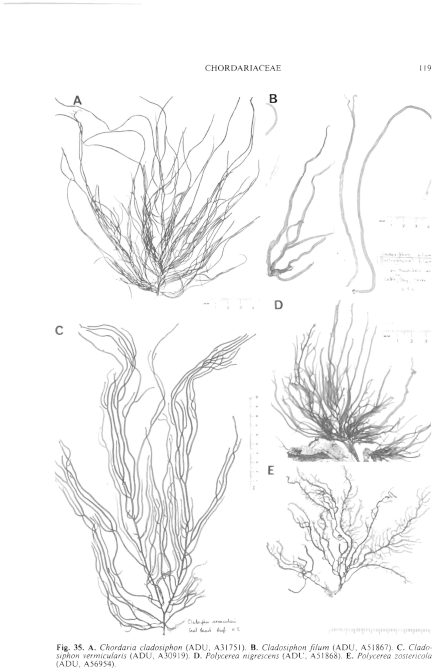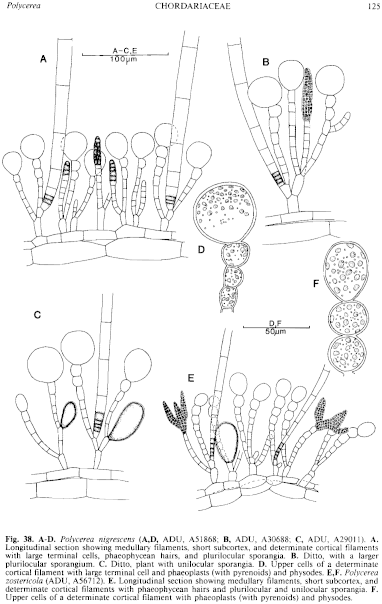|
|
|
|
|
|||||||||||
|
Electronic Flora of South Australia Species Fact Sheet
Phylum Phaeophyta – Order Chordariales – Family Chordariaceae
Selected citations: Bailey & Womersley in Womersley 1967: 234.
Synonyms
Cladosiphon nigrescens Harvey ex Kützing 1859: 1, pl. 1 fig. II. Kuckuck 1929: 58, figs 73,74.
Cladosiphon nigricans Harvey 1859b: 292.
Thallus (Fig. 35D) medium to dark brown, firm, slightly mucoid, usually much branched with a main axis and long laterals, occasionally with shorter, slender laterals, cylindrical, 10–40 cm long and 1–2 mm in diameter, epiphytic on Posidonia or Amphibolis. Basal system of juvenile plants consisting of a prostrate system of radiating pseudoparenchymatous filaments, from which the erect medullary filaments develop. Medulla multiaxial, firm but soon becoming hollow, of parallel, cylindrical, longitudinal filaments 20–60 µm in diameter with cells L/B 2–4 (–10), with slight development of hyphae. Subcortex (Fig. 38A) slight to absent, rarely more than one cell long, cells 4–10 µm in diameter and L/B (1–) 1.5–2.5. Cortical filaments (Fig. 38A–C) arising directly from outer medullary cells or in small groups from the subcortical cells, forming a dense layer with filaments 100–200 µm and 6–9 cells long, 8–10
(–12) µm in diameter and L/B 2–3 below, slightly larger above and terminated by a large, subglobose cell 30–60 µm in diameter and (2–) 2.5–5 times the diameter of the subterminal cell. Phaeoplasts (Fig. 38D) several per cell, discoid, each with a pyrenoid; physodes scattered. Phaeophycean hairs (Fig. 38A,B) frequent, arising from outer subcortical cells, 16–25 (–30) µm in diameter.
Reproduction: Plurilocular sporangia (Fig. 38A,B) borne on pedicels 4–7 cells long from subcortical cells, simple or occasionally furcate, lanceolate, becoming multiseriate, (40–) 60–100 µm long and 12–20 µm in diameter. Unilocular sporangia (Fig. 38C) rare, on plants without plurilocular sporangia, formed laterally at base of cortical filaments, ovoid, 60–80 µm long and 25–35 µm in diameter.
Type from Western Port, Vic. (Harvey, Alg. Aust. Exsicc. 94); in Herb. Sonder, MEL, 8619; isotype in NSW.
Selected specimens: Thomson Bay, Rottnest I., W. Aust., on Posidonia australis, 1–2 m deep (Gordon-Mills, 4.xii.1984; ADU, A56627). Between Thistle and Hopkins Is, S. Aust., 6–10 m deep (Baldock, Dec. 1963; ADU, A2901I). Cable Hut Bay, Yorke Pen., S. Aust., upper sublittoral on Amphibolis antarctica (Womersley, 9.xi.1980; ADU, A51868-"Marine Algae of southern Australia" No. 250), and on Caulerpa cactoides (Womersley, 9.xi.1980; ADU, A51869). Muston, Kangaroo I., S. Aust., 3–4 m deep in channel (Bailey, 29.x.1966; ADU, A30688). Walkerville, Vic., drift on Amphibolis (Sinkora A1545, 23.ii.1972; ADU, A42308). Dover, Tas. (Gordon, 14.i.1966; ADU, A30043). Meredith Point, Spring Bay, Tas., sublittoral on Acrocarpia paniculata (Olsen, 2.xi.1963; ADU, A27048). Stewarts Bay, Port Arthur, Tas., 1–2 m deep on Heterozostera (Womersley, 16.x.1986; ADU, A57258).
Distribution: From Rottnest I., W. Aust. to Eden, N.S.W. (May 1939, p. 197, as Bactrophora) and around Tasmania, epiphytic on Posidonia, Heterozostera and Amphibolis (rarely on larger algae) in the upper sublittoral during warmer months (August to March).
Taxonomic notes: According to Stafleu & Cowan (1979, pp. 271, 688), Kützing (1859), although the Introduction is dated 10 March 1859, was published prior to 9 March, and Plates 1–50 were published on 1 August 1858. It thus seems clear that Kützing's name nigrescens predates nigricans of Harvey (1859b) which was published on 16 August.
References:
HARVEY, W.H. (1859b). Algae. In Hooker, J.D., The Botany of the Antarctic Voyage. Part III. Flora Tasmaniae. Vol. 2, pp. 282–343, Plates 185–196.
KÜTZING, F.T. (1859). Tabulae Phycologicae. Vol. 9. (Nordhausen.)
KUCKUCK, P. (1929). Fragmente einer Monographie des Pheosporeen. Biol. Anst. Helgol. 17, 1–93.
KYLIN, H. (1940). Die Phaeophyceenordnung Chordariales. Acta Univ. lund. N.F. Avd. 2, 36(9), 1–67, Plates 1–8.
MAY, V. (1939). A key to the marine algae of New South Wales. Part. II. Melanophyceae (Phaeophyceae). Proc. Linn. Soc. N.S.W. 64, 191–215.
STAFLEU, F.A. & COWAN, R.S. (1979). Taxonomic Literature. 2nd Edn, Vol. II, H-Le. Regnum Veg. 98, 1–991.
WOMERSLEY, H.B.S. (1967). A critical survey of the marine algae of southern Australia. II. Phaeophyta. Aust. J. Bot. 15, 189–270.
The Marine Benthic Flora of Southern Australia Part II complete list of references.
Publication:
Womersley, H.B.S. (14 December, 1987)
The Marine Benthic Flora of Southern Australia
Part II
©Board of the Botanic Gardens and State Herbarium, Government of South Australia
Illustrations in Womersley Part II, 1997: FIGS 35D, 38 A–D.

Figure 35 enlarge
Fig. 35. A. Chordaria cladosiphon (ADU, A31751). B. Cladosiphon filum (ADU, A51867). C. Cladosiphon vermicularis (ADU, A30919). D. Polycerea nigrescens (ADU, A51868). E. Polycerea zostericola (ADU, A56954).

Figure 38 enlarge
Fig. 38. A–D. Polycerea nigrescens (A,D, ADU, A51868; B, ADU, A30688; C, ADU, A29011). A. Longitudinal section showing medullary filaments, short subcortex, and determinate cortical filaments with large terminal cells, phaeophycean hairs, and plurilocular sporangia. B. Ditto, with a larger plurilocular sporangium. C. Ditto, plant with unilocular sporangia. D. Upper cells of a determinate cortical filament with large terminal cell and phaeoplasts (with pyrenoids) and physodes. E,F. Polycerea zostericola (ADU, A56712). E. Longitudinal section showing medullary filaments, short subcortex, and determinate cortical filaments with phaeophycean hairs and plurilocular and unilocular sporangia. F. Upper cells of a determinate cortical filament with phaeoplasts (with pyrenoids) and physodes.

|
Email Contact: State Herbarium of South Australia |

|